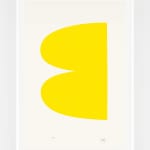-
Ellsworth Kelly
Jaune (Yellow), 1964-1965One color lithograph on Rives BFK paper35 1/4 x 23 1/4 in (89.5 x 60.3 cm)Edition of 75, plus 9 AP© 2024 Ellsworth Kelly. Courtesy of Zeit Contemporary Art, New YorkSoldEllsworth Kelly's 1964 lithograph ‘Jaune’ or 'Yellow' represents a pivotal moment in the history of printmaking, showcasing the transition from traditional representational art to the bold reductionist abstraction of modernism...Ellsworth Kelly's 1964 lithograph ‘Jaune’ or 'Yellow' represents a pivotal moment in the history of printmaking, showcasing the transition from traditional representational art to the bold reductionist abstraction of modernism and minimalism. The present work is characterized by its striking use of a single, unbroken expanse of vibrant yellow, which not only challenges conventional notions of art but also enhances the viewer's perceptual experience. This lithograph exemplifies Kelly's mastery in utilizing color as an independent visual entity, breaking away from the boundaries of form and narrative. His work in the medium of lithography during this time contributed significantly to the evolution of printmaking, pushing art towards an abstract and conceptual form. This was a period when American artists were exploring new possibilities in print, and Kelly’s contributions helped solidify the role of color field painting and minimalism within this medium.
Furthermore, Kelly's approach has had a lasting impact on American art, placing him among the most influential American artists of the 20th century. His focus on the essentials of color and form resonated with the broader movements of minimalism and Color Field painting, which sought to strip art down to its fundamental aspects. ‘Yellow’ is not just a testament to Kelly’s artistic philosophy but also an artifact of its time, reflecting the cultural and artistic shifts of the 1960s. Through works like ‘Yellow,’ Kelly expanded the scope of what could be achieved in printmaking, influencing generations of artists to explore the expressive potential of color and abstract forms. His legacy in American art is characterized by his pioneering role in changing how art is perceived and experienced, emphasizing an aesthetic that prioritizes reductivism and purity over complexity and detail.
This crucial lithograph in Ellsworth Kelly's oeuvre belongs to the Suite of Twenty-Seven Color Lithographs published by Galerie Maeght, Paris. Other examples of this edition are housed in the esteemed collections of the Museum of Modern Art in New York, the Smithsonian American Art Museum in Washington D.C., The Museum of Fine Arts, Houston, The British Museum, and Tate Modern in London, among others.NOTES
This artwork is signed and numbered in pencil on the lower margin, from the edition of 75, plus 9 artist's proofs.
Provenance
Galerie Maeght, Paris
Multiples Inc., New York
Private collection, United States
Acquired from the above by the present owner
Literature
Dale McConathy. Kelly: 27 Lithographies. Paris: Maeght Éditeur, Paris, 1965, cat. 2 (another example illustrated).
Diane Waldman. Ellsworth Kelly: Drawings, Collages, Prints. New York: New York Graphic Society, Ltd., New York, 1971, p. 255, cat. 8 (another example illustrated).
Riva Castleman. Modern Art in Prints. New York: The Museum of Modern Art, 1973, p. 45 (another example illustrated).
Richard H. Axsom. The Prints of Ellsworth Kelly: A Catalogue Raisonné. Portland: Jordan Schnitzer Family Foundation, 2012, Vol. I, pp. 72-73, cat. no. 5 (another example illustrated in color).
Stephen Coppel (Editor). The American Dream: Pop to the Present, London: Thames & Hudson, cat. no. 96, p. 160 (another example illustrated in color).




